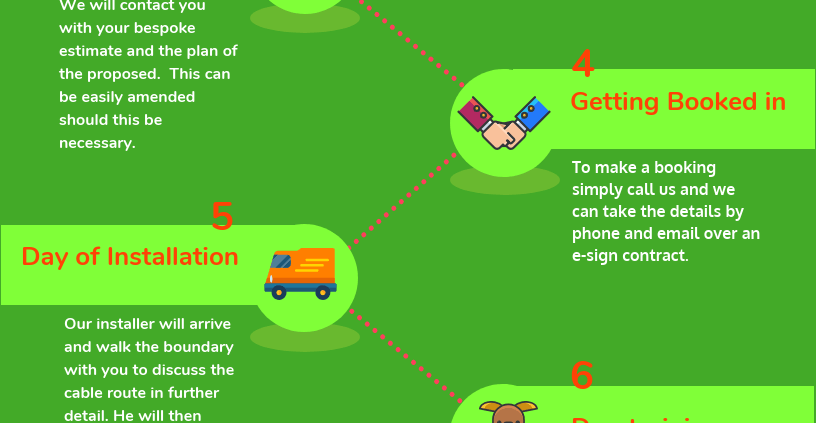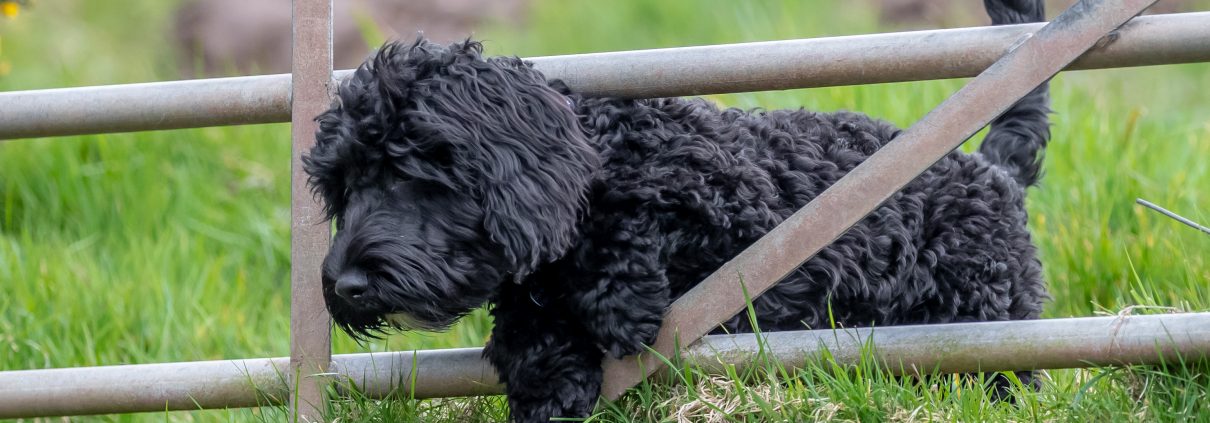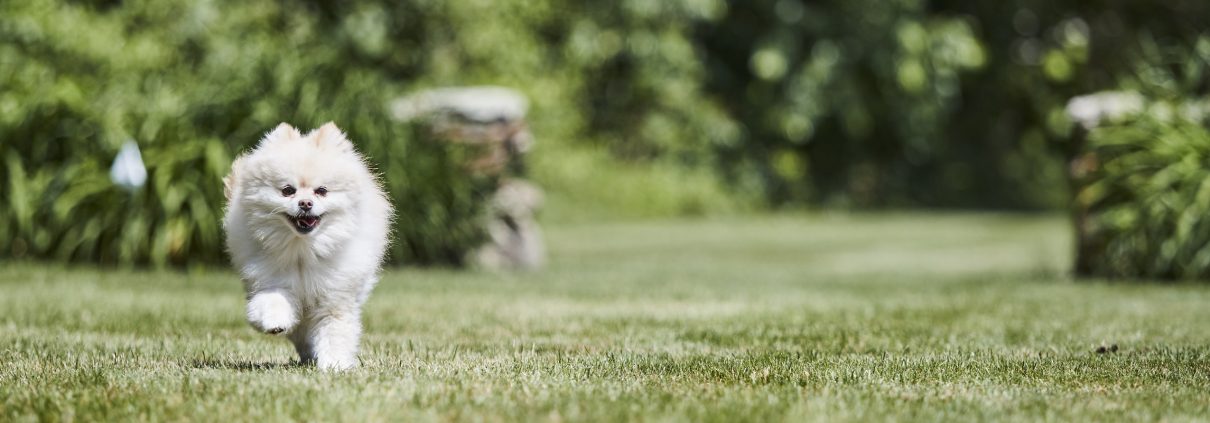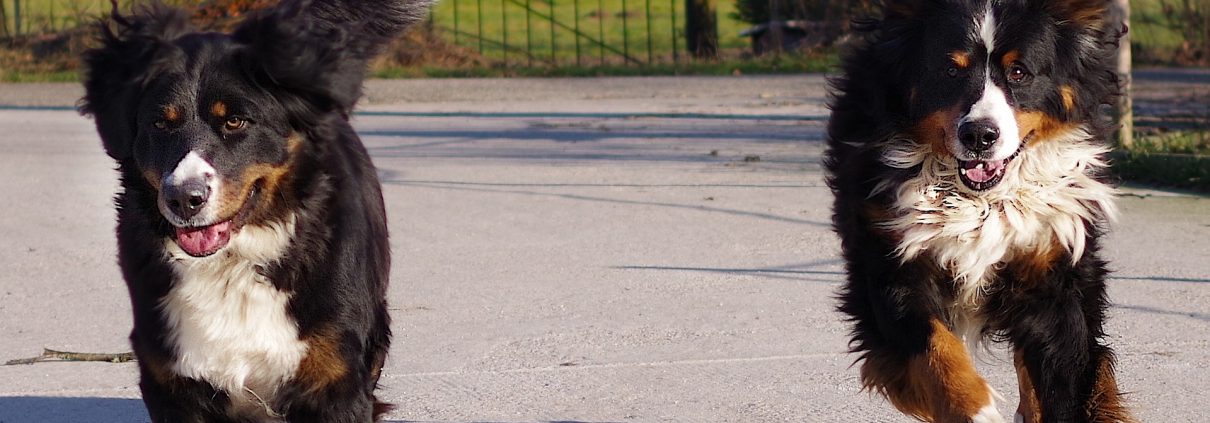Posts
Electronic dog fence – FAQ’s for new customers
What You Need to Know About our Electronic Dog Fence: FAQ for New Customers
Booking a dog fence installation
Dog fence day
As a general rule, we commence the dog fence Installation will commence circa 07.30am! Interestingly this is to avoid rush-hour traffic and maximize daylight during the winter months. Our Installer will walk the boundary with your to fine-tune the electronic dog fence route. Once this has been agreed we should not need your attention again until we commence the dog fence training.
Our unique trenching equipment will bury the cable directly into the ground. We endeavour to bury boundary cables but if the terrain or an area is not suitable we can install cable above ground. Of course, the installation duration will vary depending on the size and the terrain but as a general rule, we will be ready to train your dog in the afternoon.
Electronic dog fence training
Now for the magic! We will not hook your dog up to the mains, we will not hurt your dog, we will train your dog using a recognised protocol. Actually, the training is very subtle and for some dogs, the scariest part is the temporary training flags. These little “flag” aliens can be quite scary to some dogs and others will play or stalk them. As with people, all dogs are different as we will treat them as individuals. The flags are a vital part of the training and will give the dog a visual for the electronic dog fence boundary.
Don’t worry! Your Installer will look after your pet, he will involve you in the training and you will be amazed at how quick and simple the training is. All our Installers are trained to offer the full Dog Fence Installation & Training program. They will find the level suitable for your pet and work to ensure that he or she understands the fence.
Hopefully, he will answer all your questions but if you forget anything or you have a query you can call the office after the installation. The notes from the day will be electronically uploaded so we can access the training info and answer your questions.
Does the electronic dog fence come with a guarantee?
Absolutely! DogFence offers the most comprehensive guarantee worldwide. Our lifetime hardware warranty covers the transmitter & computer collar for life and even extends to dog chews. But more importantly, we offer a Containment Promise on professionally installed, outdoor systems.
Should your system break down for any reason you can also schedule a service appointment and one of our engineers will test or repair your entire fence or train any new pets that you may have acquired.
Is there any ongoing maintenance for the fence?
Naturally, it is important to check the fence from time to time. At DogFence we recommend testing the electronic fence monthly. This would include checking the battery and collar fit and takes less than 5 minutes. The electronic dog fence collars will alert you when you require a battery. After the dog fence installation, you will be invited to sign up to our battery program. If you decide to purchase batteries on an ad-hoc basis that’s fine. But it is important to remember that when the battery runs out the pet can run out! Other than the battery and checking the collar fit there is no ongoing maintenance required.
How often do I replace the battery in my dog’s Computer Collar?
Of course, we all lead busy lives but once you see the red flashing light on your electronic dog fence collar you need to take action. The schedule for the battery changes is as follows:
- R12m & R7m (mini) collars – every 6 months
- R12 & R9 (standard collars – every 18 – 24 months
The green status light will change from a steady flash every forty seconds to a rapid flash every 10 seconds. At this point, you have approx 2 weeks to change the battery.
Where can I buy Batteries?
DogFence offers a few different options for customers to replace batteries.
How often should I remove the electronic collar?
VVIP – the collar needs to be removed every day! Leaving the collar on the dog can cause a skin irritation. We strongly recommend that you remove the collar for a minimum of 6 hours every day but we recommend 8 hours. On the day of the dog fence installation, you will be given all this information again together with a continuation sheet to assist you in the early days’ post installation.
If you would like to know more about our electronic dog fence please call us. We can chat to you and pop together an estimate for the dog fence installation – 03450 623623 or info@dogfence.co.uk.
Electric dog fence – the myths and the truth!
What is an electric dog fence?
Electric dog fences have recently made the news. Just like Marmite, they are a contentious issue; people are either strongly for or violently against these systems.
Actually, there is no such thing as an electric dog fence. The correct name for a dog fence is a radio dog fence. A dog fence does not have any electricity in the cable and is physically incapable of electrocuting a dog or a cat. Of course, we all know that electric fence is a system used to keep livestock within an area. This type of fencing does have electricity running through the wire or net and is able to deliver an electric shock.
How does a dog fence work?
With a dog fence, the boundary wire carries a harmless radio signal. The dog or cat wears a computer collar which is programmed to pick up the radio signal. The size of the radio field can be altered to the size or breed of the pet. When the pet enters the radio signal zone the collar wakes up and gives out a high pitched warning beep. Should the pet continues further into the zone the collar gives out a static impulse; not an electrical shock. The impulse is similar to a Tens machine or abdominal exercise machine and is completely safe and harmless. The impulse is called a “correction” as it is designed to startle the pet and train them to avoid the area. The label “electric dog fence” is usually given as people assume that an electric shock is delivered when nothing could be further from the truth!
How does an electric fence work?
An Electric Fence is an electrical circuit that is charged by an electric fence energizer. A high voltage current is sent through the wire, tape or netting. The charge is sent through the fence in 1-2 second intervals. The fence acts as an open circuit. This becomes complete when an animal or person standing on the ground touches it. If an animal touches the wire the circuit closes and the current passes through the animal to deliver an electric shock.
Dog fences are cruel!
Interestingly, recent research has proved that dog fences are far from cruel, in fact, it has been proved that they save lives. Research carried out via the UK Government in conjunction with containment fence Companies and also a privately funded study through Lincoln University has proved that containment fences save lives.
Professor Daniel Mills an eminent Feline Expert “While some will argue that electronic containment systems can never be justified for pets, others highlight that, in the UK alone, hundreds of thousands of cats are killed and injured on roads each year and these devices can prevent these often fatal injuries and the emotional cost to the cats and their owners. In contrast, housing cats solely indoors to remove such risks is associated with increased prevalence of a range of health problems including obesity, Feline Urologic Syndrome and dental disease. Long-term exposure to common flame retardants widely used in homes may also have toxic side effects for cats.”
Sheep Attacks
Rising dog attacks on sheep also highlight the welfare issue that stray dogs can cause to other livestock. Stray dogs can kill sheep, cats and cause RTA’s. Farmers in many areas support the use of “electric dog fences” to keep their own stock safe. In Scotland, the increasing dog attacks on sheep has led to a public consultation regarding changing the law through a Protection of Livestock bill. Whilst the #takethelead campaign is a good starting point. Many dog attacks on livestock are from dogs that have escaped from the property. Similarly, leads can break and collars can be incorrectly fitted so training your dog not to chase sheep is a must.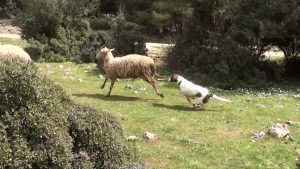
Far from being cruel dog fences save lives. Much better a small static impulse and some training than the bullet of a gun or being PTS by on a court order.
Can you use an electric fence for pets?
There is no law banning the use of electric fencing for dogs or cats. Whilst the voltage on these systems is very high no testing has been carried out to determine the long effects. There are certain safety features found within “electric dog fences” that are not found in electric stock fences.
Dog Fence verses Electric Fence
- Dog Fence – audible warning as pet approaches
- Electric fence – no warning until pet touches the wire
- Dog Fence – Automatically shuts down after 15 seconds to prevent distress
- Electric fence – will continue to shock until the pet is released.
- Dog Fence – can be used under driveways and open areas
- Electric fence – can only be used where no access is required
- Dog Fence – a static correction is humane
- Electric Fence – high levels of shock may not be good for pets.
Sadly the media and social media groups have given dog fences a bad name. Both research and those that use these fences prove that these systems save pets lives. The label electric dog fence naturally conjures up the idea of a dog being electrocuted or wired up to the electricity. Nothing could be further from the truth. We all accept that sometimes we have to deliver a small amount of discomfort to save a life. We vaccinate our pets and we microchip pet, both of which cause moderate discomfort. Yet we hear the cries of cruel and barbaric when we discuss dog fences.
Is this because people do not understand how they work or how they feel? These blogs are designed to be open and honest about how the systems work and if you would like to learn more please call us on 03450 623623 or visit our web site https://dogfence.co.uk/.
Invisible dog fence – can pets out run them?
Can dogs run out of an invisible dog fence?
When looking into purchasing an invisible dog fence one of the most commons concerns is will it work? Can the dog run out of the containment fence? Of course, just a like an ordinary fence if the fence is broken or poorly installed it won’t work. So as with any product, an invisible dog fence needs to be correctly installed but more importantly, both the dog and owner need to know how to use it.
If the fence is correctly fitted and both the pet and owner are trained then a “dog out” will rarely happen. In fact, at DogFence we are so confident we even offer a containment promise on our fully installed dog fences.
So what are the reasons that a dog may outrun a dog fence system?
1. Dead Battery
Unlike other brands of containment fences, our Invisible Dog Fences have a long battery life. However, it is still important to check the battery using the tester every 6 months on our mini collars or 18 months on our larger collars. Consistency is the key to the successful use of an invisible dog fence. If the battery runs out the dog can run out. As a rule, we find that 60% of our troubleshooting is down to a dead battery. Using an invisible dog fence is similar to using your car, it requires fuel to operate and needs topping up and checking once in a while.
2. Loose Collar
As with all brands of containment fence, collar fit is crucial. If the collar is dangling around the dog’s neck like a necklace then it will be completely ineffective! Whilst it is true that once trained 90% of dogs will never receive a collar stimulation again the impulse may need to be activated if the dog is in a high drive moment. If the dog enters the zone and carries onto in the avoidance area with no consequence he or she will quickly learn to challenge the fence. A loose collar = a dog on the lose. We always advise checking the collar fit regularly – your pet may lose or gain weight so checking the collar monthly is extremely important. Our handy troubleshooting guide shows how to test the battery and check the collar fit.
3. Invisible Dog Fence Training – lack of Training
As with anything in life you only get out what you put in! When it comes to containment fencing Training is the keyword. If your pet is not correctly trained to use the fence then it will not work for you or your pet.
DogFence is the only UK Company to offer full onsite training within the package. In 2018 the UK Government announced that they would introduce new legislation to ensure that all dog fences are sold with an installation package. At present, the legislation is still pending. It is hoped that through this legislation there will be a standardized certification program. As a small part of our customer base chose to self-install a DIY Dog Fence we offer full support. Naturally, unlike a total mail order Company, our years in the field mean that we can offer expert guidance and support to those who chose to self-install.
When is come to containment training there are 4 critical elements:
- Warning flag & audible only familiarisation
- Introduction to correction (impulse)
- Distraction Training
- Reinforcing Training
Warning Beep Training
All invisible dog fences should be sold with flags – at DogFence we use a min of 20 per 100m. The collar should be set to audible only and the pet should be introduced to the training flags. It is with warming beep that will stop the pet in a red mist or high drive moment.
Introduction to correction
The pet must be on a lead through phases 1 – 3 at all times. This is part of the training where the correct impulse level is determined for each pet. It is important to start on the lowest possible level and look for any signs of recognition/reaction to the impulse. This could be as subtle as a flick of the ear of a small flinch. All good containment fence collars should have flexible training levels.
Distraction Training
Once the pet is avoiding the training flags it will be necessary to create some distractions. These can be getting a game going with the pet, having someone else walk through the flags or bringing another dog to the property. Our DogFence Installers will usually involve the customer as part of the distraction and it’s a great way for the owner to really get involved.
Reinforcing Training
Once the pet fully understands the containment fence it is important that he or she associates it with the property and not the installer. The installer will leave full written instructions on how to carry on and when to allow the dog off the lead (cat training is carried out internally).
Freedom!
Once trained the pet has complete freedom and the owner has peace of mind.
4. Faulty equipment – Not all Containment Fences are the same!
Dogs will be dogs and the invisible dog fence collar goes through a lot of wear and tear. Many brands of containment fences are Chinese made and the quality is poor. Our invisible dog fences are high-quality but even these can go wrong. Recognizing that consistency is king DogFence offer a Lifetime Warranty on our professionally installed fences. The warranty covers both the transmitter and the computer collars. And because dogs will be dogs we add in a warranty to cover dog chews on the computer collar as well!
As with a car, it is important to check things are working. Our Installers will show you how to carry out the simple monthly checks using the testing tool. Using the correct battery is extremely important. A good quality containment fence collar should alert when a battery is required. At DogFence we recognize that people are busy so we also offer an automatic battery renewal programme.
Similary boundary wire quality is vitally important. If the boundary wire is too thin it will be very prone to damage. DogFence uses a high-quality heavy-duty boundary wire which is 25 times heavier than most DIY brands supply. When looking for an invisible dog fence look for the following:
- Long Battery life

- Lifetime Warranty on Transmitter & Collars
- Heavy-duty wire
- Professional Installation & Training
- Full after sales service
Escaping dogs will always be a problem as they can cause road accidents, kill or harm livestock or wildlife. Using a containment fence is an excellent way of giving the pet freedom but keeping them safe at home. Not all containment fences are the same and not all containment fence suppliers offer the same level of service. If you would like to receive some professional advice and information call us on 03450 623623.
Fencing for dogs we explore the options for dog owners
Best fencing for dogs – what are the options?
When is comes to fencing for dogs it really depends on several important points. A big dog will need a big fence. A four foot fence is nothing to a big dog. Equally small dogs are excellent climbers. It is important to consider the dog breed when choosing a fence. Below are some points to consider when finding the best solution for your dog and environment. All dogs are different, your dog may be fine in your present home and then you move and something changes. Ask yourself the following before choosing your dog fencing solution.
- Do you live in an urban area?
- Are you rural?
- What fencing do you currently have?
- What breed of dog do you have?
- Is the dog currently escaping?
- What size area requires fencing?
Below we have noted some of the most popular forms of fencing for dogs so that Fido stays safe at home where he should be!
Types of fencing for dogs
Chain Link Fences
Arguably this is not the prettiest type of fencing but it is one of the most economical. Chain link fencing can be built to varying heights and can also be used to construct a dog run or pen. The issue 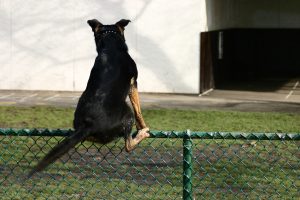 that people often have with chain link fencing is that other larger wild animals (foxes and badgers) can cause damage to this type of fence. When the fence is damaged this gives the dog an open avenue to the outside worldwide.
that people often have with chain link fencing is that other larger wild animals (foxes and badgers) can cause damage to this type of fence. When the fence is damaged this gives the dog an open avenue to the outside worldwide.
Interestingly Terriers are particularly good climbers and often see chain link fences as an easy ladder to escape. the lovely links make great foot holds for both large and small dogs. Chain link fences tend to be a popular choice for more rural customers as they can be softened with foliage. If you have a large breed of dog the fence height should be a minimum of 6ft to prevent a “climb out”.
Close Board Wooden Fences
This is probably the most popular type of fencing for urban areas. A Close Board fence can be a good option because the dog cannot see the rabbits and squirrels living on the other-side! This may curtail his desire to wander but in some cases can increase anxiety. If a dog can hear but not see what is the other side of the fence this may increase his territorial behavior and lead to excessive barking.
When it comes to fencing it’s a mid priced option if you have a small town garden. This type of fencing for dogs is usually sufficient but if your dog is a digger or a climber then this may not be the best solution. A 6ft close board fence is usually only installed in the rear of the garden so you may have to look at other options for the front of the property. Take note if your dog is a digger you should also concrete below ground!
Stock and Deer Fencing
Stocking and Deer fencing is usually only installed on large rural properties. When installing this type of fencing it is usually best to get the fence dug into the ground to prevent the dog and wildlife digging under it. This can be a costly exercise for large areas and depending on the breed may need to be quite high to prevent a “climb out”. Stock fences can be installed in front of hedges to give a secondary barrier. If you have a very small dog then a stock fence will be ineffective as the dog can squeeze through the wire.
Electronic dog fence
Incredibly, this type of fencing for dogs has been around for over 40 years. It is a little known fencing solution for dog owners in the UK but widely used in the USA. The advantage of an electronic dog fence is that it can be used on both large or small properties. The electronic dog fence is invisible and so does not create any unsightly barriers. There are several advantages that electronic fencing has over traditional methods.
- The dog cannot dig under or jumper over the electronic dog fence.
- It is cheaper than traditional fences.
- Does not obstruct views and is not unsightly.
- Can be taken with you if you move.
- Protects the drive even if the gate is open.
Even on most standard urban gardens and electronic dog fence is a most cost effective solution. It is simple to install and offers a safe and effective solution. Having been rigorously tested by Lincoln University these fences are have been proved safe and effective.
If you are intrigued but think how our fence may not work for you why not read some of our customer testimonials. If you would like to know more our experienced professionals can chat to you. We can then put together a bespoke estimate for your dog, property and budget.
For an for an estimate call or contact DogFence on 03450 623623 or info@dogfence.co.uk
Dog Fencing Ideas – how to keep Fido home!
Dog Fencing Ideas – solutions to keep Fido safe
Dogs will be dogs so exploring different dog fencing ideas is a must for any canine owner. Having spent 17 years fencing dogs we have come across many different ideas. As with people no two dogs are the same and of course they all live in different locations.
Rural dog fencing ideas
Many rural locations are difficult to fence. Understandably this could be because of the terrain being very hilly, wooded or prohibitively large. Furthermore most rural properties are surrounded by hedgerows. Hedgerows may be a deterrent for a dog with a low prey drive but for many it’s an open avenue of escape.
Stock Fencing
Stock fencing is a traditional dog fencing idea for rural properties. Used to contain livestock it is adaptable for use in rural gardens. For many dogs this will give enough of barrier to prevent the dog jumping out of the property. The downside is that this type of fencing is it is costly, unsightly and can be damaged by wildlife. Badgers and foxes will often make holes in this type of fencing and thus some rural owners find this dog fencing idea a temporary fix. Also the cost of such fencing can work out extremely expensive; starting around £6.00 p/m + gates etc it can a costly exercise.
Deer Fencing
Deer Fencing; again another great rural solution but sadly it is extremely obtrusive more expensive than stock fencing. Again, the downside with this fencing is that badgers and small mammals will make holes that then become an escape avenue for your dog!
Electronic dog fencing
Electronic dog fencing; you may not be familiar with this product even though this type of dog fencing idea has been around for over 40 years. Using a boundary wire, transmitter and a computer collar worn by the pet this type of fencing can be used on any terrain. Electronic dog fences do need to be professionally installed. This is because the pets need training but they a more cost effective solution than traditional methods. As a guide price an rural installation of approx 2 acres for 2 dogs would be circa £1300.00.
The advantage of this type of dog fencing idea is that it can be used cost effectively on very large properties (up to 350 acres) and can be removed if the owner moves house. It is also invisible so will not affect any planning restrictions or spoil the view!
Kennels and dog runs
Kennels and dog runs are full proof method for dog containment. The downside of installing a run is that many dogs become bored and exercise is limited. The cost of installing Kennels can be high but equally these can be relocated to a new property.
Urban dog fencing ideas
Most urban gardens are fenced in some way but these may not all be dog proof! Some new sites have planning restrictions on fence heights and even open plan. Many properties use Picket or Rail type fencing which dogs can easily jump over or squeeze through.
Planning permission is not usually required in urban areas. Fences must be no more than 2m high or 1m high near roads. The most popular type of fencing is for urban houses is Close Board fencing.
Close Board Fencing
Close board fencing is a great dog fencing idea for many urban owners. It is generally tall enough to stop jumping dogs and quick to install. This type of fencing comes in varying heights and can be installed by most handymen. The downside is that some dogs will dig under and there may be restrictions to installing this type of fencing on some new estates. As a rough cost to install on a small rear garden it would be approx £1200.00.
Electronic dog fencing – no need to install gates!
As with the rural properties this type of fencing is a very cost effective solution. This type of dog fencing idea also gives the owner the possibility of protecting the drive within the price. It is true that the larger the property for more cost effective the electronic dog fence becomes but small properties can also be fenced with this product.
Many owners may already have a Close Board or Picket fence installed and need additional backup. The electronic dog fence can be run around the existing fence if the traditional method is not working. Our Installers can place the cable to prevent the dog jumping over or digging under the existing fence. The cable can even be run under the drive to protect this area. Most owners are concerned that this means digging up the drive but the installation is both neat and discreet. A typical urban property would cost less £1000 to fence and this would include a driveway loop.
Cat Runs
Interestingly cat runs can be used to keep both dogs and cats safe. These type of structures can prove expensive if they are professionally installed and may not be aesthetically pleasing. A cat run suitable for a dog would usually cost from £750.00 upwards depending on the size.
A DogFence Ltd we have been Professionally installing electronic dog fences for over 17 years. The dog fencing ideas that some owners come up with to keep their pets at home can often be amusing. Over the years we have seen:
- Old Fireplaces in the hedge!
- Old garage doors down one boundary!
- Orange builders netting – not attractive or effective!
- Hundreds of dogs on tie out stakes – who have wound themselves up to the pole 🙁
- Electric horse fencing – Harsh and not fall proof!
If you would like to learn more about how we can keep your dog safe at home please call us or visit our web site. We offer bespoke Quotes using our online measuring tool – simple, accurate and effective. 01628 476475 or info@dogfence.co.uk
Electronic dog fence – How to train your dog.
Simple Steps for training your dog to an electronic dog fence
Before commencing electronic dog fence training:
- Ensure that you have the correct amount of training flags to cover the boundary. The training flags are the most important part of the training protocol for electronic dog fences. The training flags should be placed approx 8 – 10ft apart around the boundary. Use the collar to find the edge of the avoidance zone and place the flag in the ground in the area where the collar starts to beep.
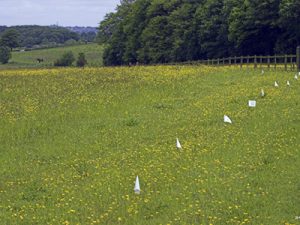
- Using the dog fence tester – set the collar to beep only mode. This means that the collar will not give out an impulse just an audible tone.
- Place the electronic dog fence collar on the dog and check that it correctly adjusted. As a guide you should be able to get 2 fingers in the neck strap when the dog’s neck is down. See our Trouble Shooting page for handy tips.
- Leave the collar on the dog for at least 30 mins before commencing the initial training session.
- Find a long lead – 6ft and ideally not the dog’s usual walking lead.
Commencing the training
- Take the dog outside on the lead.
- Walk the dog around the boundary and tap the flag so that there is good movement.
- As you tap each flag use a command word – a good example is “Watch out”.
- Allow the dog to go past the training flags into the correction zone (this is the area of the electronic dog fence where the collar will give both a beep and impulse). Allow the dog to linger here and hear the warning beep then direct him back into the garden. Use the command word and tap the flag again.
- Repeat this around the boundary for several small sessions over 1 – 2 days.
Introduction to Correction
- Place the electronic dog fence collar on the dog approx 20 – 30 mins before starting the training.
- Using the tester – lift the level on the receiver from level 0 (beep only) to level 1.
- Repeat the process of walking around the boundary and tapping the flags. Always use the command word when tapping the flag.
- Allow the dog to go past the flags into the avoidance zone. Look for any signs that the dog is feeling the impulse (a small twitch of the ear, little shake of the head).
- Carry on around the boundary allowing the dog to walk into the avoidance zone of his own free will. Never call or drag the dog into the electronic dog fence zone.
- If the dog is not responding to the level – lift the level to level 2 and repeat the process. Always direct the dog back into the safe area and praise the dog when he is back in the safe zone.
- Once the dog is reacting to the stimulation make a note of the level.
- After training play with your dog, praise him and reward him. Do not allow the dog to be off the lead in the garden during the training phase.
Introduction to Distractions
It is important the dog fully understands the warning beep and how to retreat when he is in a high drive moment. By carrying out the distraction training your dog will learn the electronic dog fence so that it becomes second nature. This will ensure that even when he is in a high drive state he stops at the warning beep. The distraction training will require 2 people.
- Walk around the boundary, tapping the flags and then have the new person walk into the flags and well into the avoidance area. See if the dog continues or decides to stop.
- If the dog continues allow him well into the zone to receive the stimulation and guide him back to you in the safe area. Give him the command word whilst guiding him back to the safe area. Praise him in the safe area.
- If the dog stops before or at the flags guide him back and praise him.
- Continue walking around the boundary and repeating the process.
- Once the dog is making the right decision (not walking into the flagged area) move on and try this on the driveways or open areas.
- If the dog is making good progress you may wish to drop the lead and walk into the flagged area with the companion. If the dog endeavors to follow give the command in aloud and firm voice.
- A good indication that the dog is fully at home with the electronic dog fence is when he looks away from the flags.
Repeat this process over a couple of days.
Letting your dog off the lead
- Walk the dog around a couple of areas and tap the flag if possible. Usually by this stage the dog will not venture near the flags so just give the command word even if you are several feet away from the flag.
- Go to the centre of the property and face the dog away from boundary.
- Remove the lead and start to walk back towards the house or a safe area.
- Play with your dog outside – you can roll a ball but always roll away from the avoidance zone.
- Do not leave the dog unsupervised in the garden for the first few days.
- After 14 days you can start to remove the flags. Remove the flags every other flag, every other day until they are gone.
Keep the flags in a safe place as if you wish to add on another pet you will need to re-flag the boundary and if you change the layout this will need to be re-flagged to give the dog a visual.
Points To Remember
Training your dog to the electronic dog fence should be fun!
Never throw a stick or ball into the avoidance zone.
Small bit size sessions are often better.
Always remove the dog fence collar at night or for a period of 8 hours in every 24 hour period.
Check the fit for your electronic dog fence collar regularly.
Check the battery status on your collar monthly (using the tester supplied).
DogFence Ltd are the largest installers of electronic dog fences in the UK. Our professional installer/trainers can set up your dog fence for you and will train your pet to the system. We also offer a post installation service to train new pets to the system. If you would like more information please call us on 01628 476475 or email info@dogfence.co.uk.
Fencing For Dogs Who Escape
Fencing for dogs – Which Fence Is Best?
Here you are finding yourself researching about fencing for dogs. I am guessing your canine companion is one that is a great escape artist! I have one too and not one who jumps over a fence but one who finds the smallest gap and squeezes himself out or it maybe you have a high energy dog who just loves attention from any passing people or other dogs, whatever breed you own, a dog is always on the lookout for freedom to roam.
Frequent escapes create a number of worries for you as a pet owner:
- Theft.
- Become a bait dog.
- Poisoned.
- Even shot for chasing livestock.
- Picked up by the local dog warden (which costs you).
- Be at risk of injury or hit by a moving vehicle.
All of these worries are real today! Dogs do not see these dangers, they escape because they can and often if left for long periods of time, because of boredom.
There is a simple solution to this issue of fencing for dogs and that is for an invisible or hidden fence. Whereas a static fence:
- A dog can jump over.
- Dig its way out underneath.
- Chew through in a bid for adventure or someone to be with.
Interestingly, people often say a dog can run through the wired or wireless system – however…read on and you will see why this is and why DogFence systems do not pose this issue.
Wired or Wireless Fencing For Dogs
Sadly, there has been much stigma about electronic fences and shock collars but the collars available today are far removed from the collars available 40 years ago. Today’s systems have improved massively in terms of stimulation levels, size of receiver collars, training etc. People are concerned that these fences may be illegal. All our DogFence systems are 100% legal. Of course, our legal dog fences come with patented fail-safe FM radio frequency technology. Unlike the AM frequency dog fencing systems, it will not fail or activate accidentally.
Wireless dog fence
Most dog fences are wired but wireless systems are available but are often not as effective due to the constraints regarding lay of the land etc. With the wireless installations, there can be issues with undulating terrain, trees, and building and these types of pet fence are highly prone to false activation. Whilst they may be quick to install, sadly the end result can be confusion for the dog. As with any Pet Training protocol it is best to take time. Taking a day or so to install a wired fence will give your dog more freedom. If your dog is happy and safe then this will also give you peace of mind as well.
Of course, wireless dog fences have a few advantages over their wooden or chain-linked counterparts. Many electric dog fences require few tools to install and can be set up in an afternoon. Unlike a traditional gate, the layout of many invisible dog fences isn’t as restricted by the topography of your garden. Using an invisible fence does not obstruct your view, it is ideal for creating a space for your dog. A wireless dog fence allows you to increase the range of your boundary area. You can link additional receiver collars to increase the range of the signal.
What is an Invisible Dog Fence & How Does It Work?
- An FM radio signal created a virtual fence. Dog Fence uses the Safelink patented FM digital technology.
- 15 times faster than AM radio signal fence systems.
- An invisible fence can cover a large area (at a fraction of the cost of traditional fencing).
- The radio signal transmits to a collar worn by the pet.
- A zone before the boundary triggers a high pitched beep from the collar, to warn your pet.
- At the boundary, your pet gets a warning beep and small static impulse, through the collar.
- Temporary training flags are installed to give the pet a visual
- Through training, the pet learns to retreat to a safe area.
- Maximum protection against false activation.
- If a correctly trained a dog cannot run out of an FM radio signal.
- 2-5 days training programme for your pet.
- Suitable for dogs over 12 weeks and cats over 16 weeks.
- Discomfort from the impulse, experienced by your pet, occurs mainly during the initial training. It feels no worse than an annual vaccination. The stimulation cannot compare to the pain of being hit by a car!
- Costs a fraction of the price of installing a traditional fence.
Conclusion
All things considered, the best fencing is a hidden containment fence, one which transmits over FM frequency. After all, we are pet lovers and the importance of our pet’s safety should not be underestimated. Pet shelter organisations do require you to have secure fencing in place before approval of adoption too. With other types of fencing for dogs, a pet has the means to escape. You want peace of mind that the fencing you choose is secure enough to keep your pet safe.
To conclude, hidden legal dog fences are the best choice, due to the following factors:
- They are highly effective at pet containment.
- The fence is invisible and does not obstruct your view.
- A cost-effective solution that allows freedom for a safer, happier, independent pet.
- An easier life for you the pet owner having less worry.
- They are professionally installed.
DogFence Ltd offers a pet training programme as part of its installation service. This is designed to minimise the static shocks, to your pet, by ensuring can teach your pet it’s new boundaries. So don’t wait, get in touch with our friendly team here at Dog Fence today for an informal chat about fencing for dogs to suit yours & your pet’s needs.
Related posts:
Electric Dog Fences Weighing Up The Pro’s & Con’s
Electric Dog Fences Are The Cruel
8 Top Tips To Stop Dogs From Escaping
Electronic dog fences – are they safe for small dogs?
Are electronic dog fences safe to use for small dogs?
Electronic dog fences have been around for over 40 years. Unsurprisingly in the early years this type of electronic dog fencing was most certainly not suitable for small dogs. Why were they not suitable? Size and weight of the computer collars! Many of the early collars used a 9 volt battery to power the collar which was both bulky and heavy. As with mobile phones recent advances in technology have enabled the size and weight of the computer collars to be dramatically decreased.
At DogFence we are proud to be able to offer the smallest and lightest electronic dog fence collars on the market today. Our mini computer collars weigh only 30g including the small 3.0 volt battery. Our electronic dog fence collars are suitable for all breeds of dogs and cats and with the increasing popularity of toy breeds our sales of mini collars has risen significantly in the last 5 years.
Will the electronic dog fence hurt my dog?
Naturally a common concern is that the “correction” or impulse will hurt the dog. Naturally, at DogFence we are all dog lovers and the last thing we would want to do is inflict pain or suffering onto any dog or cat. The impulse level is set to each dog or cats personality. People often asks does it hurt? can I feel it? In reality, once they feel the impulse the next reaction is usually “how will that keep my dog in?” or “oh it’s not that bad!”.
Electronic dog fences have been tested by leading Universities and pet professionals across the world. The results have proved that these fences are safe to use with both dogs and cats. The amount of impulse delivered is not determined by the size of the pet but their personality. The average setting for most dogs is level 2 this would equate to some 250 times lower that a cattle of electric stock fence.
Interesting, the impulse is generally only received during the training phase. All our electronic dog fence collars give out a warning beep prior to giving out the impulse. During the training phase the pet also has a visual marker with training flags. If the training is carried out correctly the pet will rarely receive any activation after the initial period. All our DogFence installers are qualified to train your dog or cat to the containment system. DogFence is a member of the IACP an international organisation set up for training dogs using electronic stimulation alongside conventional training protocols.
Will I have to use the electronic dog fence forever?
This is always a difficult question to answer. It really depends on your dog’s personality and hunting drive. As a rule we find that dogs and cats that are trained before the escaping behavior begins will train quickly and easily and never challenge the fence. However, if you have livestock or game birds nearby and a dog with a high drive then it is advisable to use the system everyday. With electronic dog fencing consistency is king. If every time the dog enters the zone they hear the warning beep they will not “challenge” the fence. Issues can arise if they can go through the zone one day because they are not wearing the electronic dog fence collar and not on another day it becomes confusing to the pet.
What do the Experts Say?
Recent studies through Lincoln University, headed by the well revered Prof. Daniel Mills, and the Governments research have proved that electronic dog fences are only safe and also save the lives of dogs and cats. With modern technology size is no longer a barrier to pet containment with an electronic dog fence. Read more about what the experts say on our web site.
If you would like to learn more about how an electronic dog fence can keep your pet safe contact us on 01628 476475 or email us @ info@dogfence.co.uk.
How to stop the dog escaping from the garden?
Ways to stop the dog escaping from the garden?
A common question that we hear from owners is how can I stop the dog escaping from the garden. Dogs will be dogs, some escape because they have a high prey drive or they are bored, sometimes it’s food driven. When considering dog proofing the garden there numerous options available. An escaping dog is not only dangerous but can be very stressful.
Traditional Fencing:
Close board or wooden fencing is a popular option for smaller properties. The cost of close board fencing starts from around £80.00 per meter installed but it depends on the property location and terrain. Stock fencing is a slightly more cost effective solution for some properties but may not be secure enough for small dogs and of course dogs will be dogs and they can dig and burrow under both close board or stock fences. In general the weakest part of the property is the driveway. To dog proof a driveway can run into thousands depending on the type of gates chosen. If the dog is escaping onto a road then securing this area is a priority but will be costly and so a traditional fence may not be the best solution to stop the dog escaping from the garden
Radio dog fences
Radio dog fences have been available for over 40 years but many people still do not know that they exist. They are often referred to as invisible fences or a freedom fence. A radio dog fence is usually a much cheaper method to help prevent the dog escaping from the garden. The fence is more like a virtual fence – there is nothing to see and the fence can cover large areas or areas that would not easily be fenced by a traditional fence. A radio fence is a simple solution to stop the dog escaping and in monetary terms an inexpensive solution.
So what is a radio dog fence. In simple terms it is just a radio transmitter, a boundary wire that surrounds the boundary or the area to be “fenced” and an innovative computer collar which is worn by the pet. The transmitter sends a coded signal through the boundary wire and a “no go zone” is set when the pet enters the no go zone the computer collar activates and lets out a high pitched warning beep to alert the pet that they are in the wrong area. If the pet continues further info the zone the collar then gives out a small static shock (correction) which is set to the pets personality. With the assistance of some temporary training flags and training from the fence installer the pet quickly learns where the boundary is.
The great advantage of radio dog fence is that is covers all areas including the driveway so if someone leaves the gate open the pet cannot wander in the road. Also the radio signal is 360 degrees around the cable so dog or cat cannot climb over or dig under the signal. With the DogFence system the signal is also quicker than any other pet fence worldwide so that dog or cat cannot out run the fence.
Electric stock fencing:
Electric fencing or electric stock fencing can be used for pet containment but it is not advisable and the shock given out by an electric dog fence is 250 times higher than the output on a radio dog fence. Also with an electric fence if the pet gets stuck in the fence they will continue to be shocked until the fence stops or they are rescued but with a radio dog fence the fence shuts down after 15 seconds to ensure the pet is not over corrected. Of course an electric fence is not only more expensive but cannot cover gateways or driveways and if there are children or members of the public close by they are also affected by the electric fence.
Dog Runs
Dog runs are a great solution for keeping your dog within a confined area of the garden but these can be very costly and unsightly and of course will only give the dog a limited area to use. It is also advisable to install a dog kennel within the run so that dog has somewhere to go to if it is very hot or rainy. In some areas planning restrictions may apply and it is always advisable to check with our local council.
Other Solutions to stop the dog escaping maybe to try to train the dog to stay in the garden, for some breeds this maybe a workable solution but for those with a high prey drive or who have had a previous history of constantly escaping the drive to leave the property may be too great.
Summary
Here at DogFence Ltd we meet customers with different breeds and personalities but they all have one thing in common! they want a solution to the stop the dog escaping. Many have tried other forms of fencing and many are sceptical as to whether a radio dog fence will work. Our customers are our best advertisement (Customer Testimonials).
If you would like to learn more about our radio dog fences please call us on 03450 623623 or visit our web site www.dogfence.co.uk.

